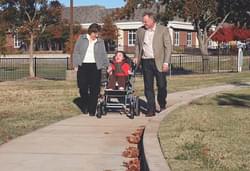




This trail includes sections made of different materials that can teach children with disabilities how to maneuver on surfaces such as rubber, pea gravel, mulch, boardwalk decking, and concrete pavers.

From the Children’s Center, Bethany, Oklahoma
A unique “barriers” trail is helping patients at the Children’s Center learn to maneuver on and around common barriers in a safe environment. The trail is one part of a larger project, for now called “The Children’s Center Park,” which will provide strategic areas for therapy, education, and relaxation to patients and their families.
The barriers trail will be located on one side of a drainage pond that has been reconstructed for therapeutic and recreational purposes. The trail will include at least nine “pods” or surface challenge areas made of materials patients may face in everyday situations. Materials include screed finish concrete, a rubber surface, pea gravel, brick with mortar joints, mulch with barrier timbers, boardwalk decking, contoured water surfaces, limbo bars, and concrete pavers.
The purpose of this trail is to provide a safe environment for individuals who use wheelchairs, walkers, or other mobility supports to practice navigating features that pose a challenge when encountered throughout the communities in which they live.
The need for the project was first recognized by the Center’s physical therapists and recreational therapist when some children were unable to go on a field trip to an area park because they were not well enough. The close proximity of the pond and park will allow the children to be within easy access to the hospital in case of emergency.
The park and pond project will include a nearby steel pavilion for relaxation, a double tee concrete bridge, a fishing dock for patients, a covered patio, a garden, and a commons area for pet therapy and Frisbee. Interior and exterior sidewalks along the northern and eastern edges of an existing baseball field will provide access to a picnic area on the southern part of the grounds and will connect to the Center’s Farmers’ Market area, just north of the pond.
A sidewalk, wide enough for two wheelchairs to ride side-by-side, will wrap around the perimeter of the 30-acre campus. Eventually, signs will be placed along trails to help the community better understand the mission of the Center.
The trail was inspired by 19-year-old Aaron Bullock, a former patient who had to learn how to walk again by going to different parts of the city for challenging surfaces.
Aaron returned to the Center to complete his Eagle Scout project that is part of the Center’s barriers course, a one-of-a-kind trail featuring common obstacles that children with physical disabilities must learn to overcome.
For two years, Aaron struggled to relearn life after coming out of a coma and undergoing intensive rehab in the Center’s Pediatric Medical Rehabilitation Unit. Aaron stood proud while attending his Eagle Scout Court of Honor award ceremony, an honor he earned after completing his portion of the barriers trail.
Aaron continues to speak to children about riding ATVs safely through testimonials presented by ATV Ride Safe Oklahoma, an initiative between The Children’s Center, The Trauma One Center at OU Medical Center, and Oklahoma State University Extension 4-H Youth Development. The program emphasizes safety, injury prevention and training through the proper use of four-wheelers.
Funding for the park and trails was provided by grants from the U.S. Fish and Wildlife Service, the Oklahoma Department of Transportation, and the Oklahoma Recreational Trails Program. The trail connects to many different areas in the surrounding community. The project also includes a pond, bird houses, bat houses, and picnic area. The park is open to the public; however, a fence is constructed around the pond area for safety reasons.
In 2012 the trail project was a winner of the Coalition for Recreational Trails 2012 "Annual Achievement Awards" in recognition of outstanding use of Recreational Trails Program funds.
See “Bullock’s Barriers,” a video featured on HopeTV: www.youtube.com/tcchopetv